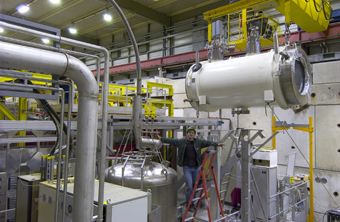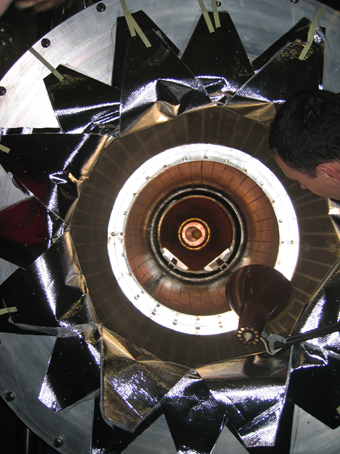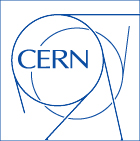A new
magnet at CERN is going to allow COMPASS (Common Muon Proton Apparatus
for Structure and Spectroscopy) maximum acceptance. Thanks to the 5
tonne, 2.5 m long magnet, which arrived last December, many more events
are expected compared to the previous data-taking.

COMPASS' new magnet is placed inside the experiment, which will allow for maximum acceptance.
The aim of COMPASS is to study how quarks and gluons form hadrons and,
in particular, what contributes to the spin of the nucleon (protons and
neutrons). The experiment, which started to take data in 2002, uses a
polarized target in which nucleon spins are aligned and hit with a muon
beam from the SPS. The muon beam probes inside the particles. A
magnetic field of 2.5 tesla is applied, along with a cold temperature
of 50mK sustained for the polarized target, making it the coldest place
at CERN.
It will now be easier to detect particles produced
at large angles from collisions in the target, mainly as a result of
the unique characteristics of this new magnet, which has an inner
opening of 63 cm. Upcoming improvements to the tracking system will
also aid physicists in finding particles that would have been
previously absorbed into the former magnet, which had a 27 cm opening.
A dramatic increase is expected for those events. 'We will have a
larger angle to track and detect,' said Alain Magnon, co-Spokesperson
for COMPASS.
The British company, Oxford Danfysik, reworked
the magnet in 2003 and 2004 after Oxford Instruments experienced
problems completing the project. An International Review Committee
involving experts from CEA-Dapnia, CERN and KEK oversaw the redesign of
the main magnet coil. Once finished, it spent one year at CEA, where it
was tested and instrumented. COMPASS specified to Oxford Instruments
that they wanted to obtain a magnetic field uniform to one part of
10,000, or ±10-4. A perfect uniformity of the field is needed in
order to obtain a uniform polarization of the spin inside the target.
During testing, the team at CEA found that they were able to establish
a magnetic field map with a homogeneity of ±3x10-5, three times
better than required.
To create the uniform field needed, a
rather sophisticated magnet, much more complex than a simple solenoid,
had to be designed and built. The number and variety of the different
coils that form the magnet are the key to the high uniformity. There
are two large compensator coils at either end of the magnet and sixteen
correction coils placed throughout the volume. Finally, two 'saddle'
coils, one on top and one on the bottom, are used to change the
orientation of the magnetic field rapidly in order to rotate the
particles' spin into another direction.
Although the project
for this new magnet had to pass through a number of difficulties, 'it
was a very good example of collaboration with a lot of effort by all
parties in order to solve the problems,' said Alain Magnon.
Currently, the magnet is fully installed in its intended location in
Building 888 and testing is underway to see if it has the same
properties as previously demonstrated at CEA. This is important because
there are some minor concerns of interference with the magnetic field
from large magnets nearby.
In order to take advantage of the
new possibilities achievable by the new magnet, COMPASS will upgrade
some detectors in its spectrometer before the next run, scheduled to
start in June 2006. The tracker, which comprises a total of 320,000
detection channels, will be reinforced particularly to cover the new
angles. The Ring Imaging Cherenkov (RICH) will get faster readout and
better photon detection in the centre. The experimental programme will
span the coming five years. 'We are working hard to make improvements
in 2006 for better performance of particle identification and tracking
to maximize the acceptance and efficiency of the spectrometer,'
explained COMPASS co-Spokesman Gerhard Mallot.

A glimpse inside the sophisticated solenoid magnet.
COMPASS
is a collaboration of 250 people from Europe, India, Japan and Russia.
The experiment started to take data in 2002 and physicists have already
analysed data from 2002 and 2003. Among the first results, one of the
most interesting is related to the role played by gluons, the particles
that glue the quarks together inside nucleons. COMPASS has already
shown that the participation of gluons in the spin of nucleons is not
as large as many theorists expected.
|





